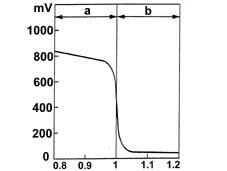3232853 - 1080B exhaust emission control system
The electronic control unit identifies the
composition of the mixture (rich or lean) from the Lambda sensor output
voltage.It adjusts the quantity of fuel injected
to ensure the optimum composition of the mixture (l = 1) to create
the ideal conditions for the treatment of the exhaust gases in the
catalytic converter.If the mixture is too rich (lambda less
than 1), then the quantity of fuel should be reduced and, if the
mixture is too lean (lambda greater than 1), then the quantity of
fuel should be increased.
a, Rich mixture (lack of air)
b, Weak mixture (too much air)
Lambda probe
Of the 'planar' type, it is mounted on the
front section of the exhaust pipe, and it informs the control unit about
the combustion trend (stoichiometric ratio).
To obtain an optimum mixture, the quantity
of air drawn in by the engine is the same as the theoretical quantity
that would be needed to burn all the injected fuel.In this case the Lambda factor (?) the ratio
between the quantity of air drawn in and the theoretical quantity of
air (needed to burn all the injected fuel), is 1.Thus:
- Lambda = 1: ideal mixture;
- Lambda greater than 1: lean mixture;
- Lambda less than 1: rich mixture.
a, Rich mixture (lack of air)
b, Weak mixture (too much air)
The Lambda sensor, placed in contact with
the exhaust gases, generates an electrical signal whose voltage depends
on the concentration of oxygen present in the gases.This voltage undergoes a sudden variation
when the composition of the mixture moves away from the value ?
= 1.The heating of the Lambda sensor is managed
by the fuel injection control unit in relation to the exhaust gas temperature.This avoids thermal shocks on the ceramic
casing due to the contact with condensed water, present in the exhaust
gases when the engine is cold.The measuring cell and heater are built
into the 'planar' (stratified) ceramic element, with the advantage
of obtaining quick heating of the cell, thus permitting a closed
loop' check (? = 1) within 10 seconds of engine start-up.
1, Connecting cable
2, Protective sleeve
3, Planar sensor element
4, Ceramic tube casing
5, Probe seating
6, Ceramic seal
7, Protective tube
The operation of the Lambda sensor is based
on the principle of an oxygen concentration cell with solid electrolyte.The surfaces of the measuring cell are coated
with microporous layers of noble material.
1, Exhaust gases
2, Passage of reference air
3, Heater
4, Lambda sensor voltage
For operating checks
See Test 1080B Check operation of fuel vapour recovery solenoid
valve
.
Catalytic converter
The three-way catalytic converter
simultaneously reduces the three polluting gases present in the
exhaust gases:
- unburnt hydrocarbons (HC);
- carbon monoxide (CO);
- nitrogen oxides (NOx).
Two types of chemical reactions take
place in the converter:
- oxidation of the CO and HC, converted into carbon dioxide
(CO2 ) and water (H2 O)
- reduction of the NOx converted into nitrogen (N2 ).
The converter consists of a monolith, a
metal mesh support for damping impacts and vibrations and an outer stainless
steel housing resistant to high temperatures and atmospheric agents.The monolith consists of a honeycomb structure
comprising a ceramic material coated with a very thin layer of catalytically
active substances, platinum or rodium. These accelerate the chemical
decomposition of the harmful substances contained in the exhaust
gases which, passing through the core cells at temperatures of over
300°- 350° C, activate the catalyzers, thus starting the oxidoreduction
reactions. To optimize the efficiency and duration
of the catalyzer, a perforated plate metal cone improves the diffusion of
the exhaust gases in the cells of the ceramic core.
1, Ceramic monolith
2, Metal support
3, Outer casing
4, Perforated plate metal cone
 | The noble metals contained in
the catalytic converter, because of the high temperature, are chemically attacked
if lead is present.For this reason the use of petrols containing
lead should be avoided, otherwise the converter will be quickly
and irreversibly damaged.Never use petrol containing lead,
not even in an emergency or for a very short time. |




